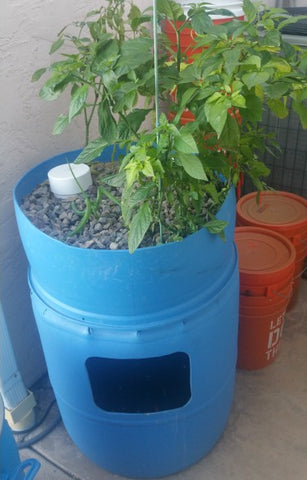There is no question why indoor gardening has become popular in some homes today. People discovered that houseplants and some food crops could do well in indoor garden settings. Indoor gardening also has a super positive effect on the health of people and it makes sense that if you are going to grow plants, then grow plants that will give you benefits while helping decorate and beautify your house.

What is Indoor Aquaponics?
Indoor Aquaponics is the rearing of fish and growing plants in an indoor setup. Plants don't really need soil to grow; they just use soil to get nutrients and water. If you can give nutrients and water to your plants in a close setup indoors with sufficient lighting, then you can bypass the importance of soil in growing plants.
In aquaponics, the fish and plants live in a symbiotic relationship where the fish produce wastes that are full of nutrients for the plants. In return, plant roots filter and clean the water before it returns to the fish tank for the fish to live. This process is done through the help of the nitrifying bacteria, that converts fish waste into natural fertilizers for the plants.
Benefits of an Indoor Aquaponics Garden
Clean Air
One benefit of having an indoor aquaponics garden is the plants produce clean, fresh air inside your home. Having plants that constantly purify the air supply is good for you and your family's health.
Food Security
When you have your own indoor vegetable or herb garden, you'll always have access to fresh, delicious, and healthy products every day. Having an indoor garden is also another way of ensuring your family's supply of fresh and healthy food and having the security of knowing where and what is in it.
House Decoration
Aside from providing fresh harvest, a beautifully designed indoor aquaponics garden can be a beautiful part of your home decor.
Therapeutic Benefits
It's not just the beautifully designed indoor aquaponics garden that is beneficial, but also the fish and water. Indoor systems with lit aquariums filled with brightly colored fish can help relieve anxiety, heart rate, and lower blood pressure. In addition, the gentle sounds of the flowing water can create a tranquil, meditative state that helps bolster the feelings of wellbeing.
Saves Water
In an indoor aquaponics setup, the water is recycled because it never leaves the system but just recirculates from the fish tank to the grow bed over and over again. So it uses 90% less water than other gardening methods.
Year-Round Gardening
Because you can control the environment in an indoor garden, you will be able to grow plants all year round.
What You Need to Get Started with an Indoor Aquaponics Garden
You can set up your indoor aquaponics garden with a few basic materials. But, if that sounds like a hassle and budget is not a problem, you can purchase a ready-to-use aquaponics home system kit. These kits only require you to add the fish and plants and have many options that will fit your gardening needs.
However, if you want something cheaper and custom fit to your gardening needs, you can make your own indoor system using cheap or recyclable materials like IBC tanks or blue barrels. Here are some kits and DIY indoor aquaponics systems that you can set up for your own indoor aquaponics garden.
Home Aquaponics Kit Ideas
Go Green Aquaponic System
The Go Green AquaponicsSystem kit is for aquaponics enthusiasts who want to start small in an indoor or outdoor set up. The kit comes in a “Single Grow Bed System” or “Double Grow Bed System.” This is a complete kit that includes a grow media, pump, a digital thermometer, all plumbings and a Master API water test kit. If you’re a total beginner, this kit is great for you because it also comes with instructions and 5 hours of short aquaponics online courses. This home system kit is great for kids and adults who want a hassle free start to aquaponics.
AquaSprouts Garden
If you want a little countertop indoor garden for a few herbs, this 10-gallon Aquasprouts Garden for indoor aquaponics system is for you. It comes in a modern black matte design so that it will look beautiful in your kitchen.
DIY Indoor Aquaponics Garden Ideas
DIY One Barrel Aquaponics System
You will just need a barrel, drill, and jigsaw to build this simple DIY One Barrel Aquaponics System. The step-by-step guide with photos will explain the process of making the single barrel aquaponics system. This type of aquaponics system is excellent for aquaponics beginners who want to start small and save on start-up costs.

Easy DIY Aquaponics System
If you already have an aquarium but want to get into aquaponics, then building your aquaponics system is a piece of cake. You can add a grow bed to your aquarium fish tank and start growing your vegetables. This step-by-step tutorial video will help and inspire you to start making your own aquaponics system.
What plants can be grown in an Indoor Aquaponics Garden?
The best plants to grow in aquaponics systems depend on their size. A small indoor aquaponics garden will have fewer fish, lesser waste, and lower nutrients. So plants that are smaller and require lower nutrients are the best plants for these systems. Plants with lesser nutritional needs are greens and herbs such as lettuce, kale, spinach, swiss chard, arugula, mint, chives, basil, and watercress.
What Fish Grows Best in an Indoor Aquaponics Garden?
As with any aquaponics system, choosing the right fish will affect the success of your indoor aquaponics garden. Unlike any standard aquaponics system, an indoor aquaponics system does not use edible fish, since there is not enough room for growth in a small fish tank.
In small systems, the best species are fish that do not grow big when they reach maturity, such as goldfish, fancy guppy, betta, tetras, dwarf gourami, and pencil fish. It is also important to choose fish that is locally available to your location to withstand your climatic conditions, such as pH and temperature.
Components of an Indoor Aquaponics Garden
These are the essential components of an indoor aquaponics garden.
Fish Tank: The fish tank is where the fish reside. Depending on your design and size, an indoor fish tank can be an aquarium fish tank, a 55-gallon barrel, or an IBC tote. The fish tank should be made of food grade or non-toxic materials, and if you're using a recycled barrel, make sure that it was not used to store any chemicals. The fish should also be large enough to meet the needs of your fish and plants.
Grow Bed:The grow bed is where your plants will grow, so it should be durable and strong enough to hold the water and the plants. It should be made of non-toxic materials and deep (10 - 12 inches deep) enough to sustain the proper root growth of the plants.
Grow Media: The grow media supports the roots of the plants and serve as the surface area for the bacteria. The most common grow media used in aquaponics are clay pebbles, expanded shale, gravel or lava rock, and other inert media.
Pump: The water pump transports the water from the fish tank to the grow bed. Submersible pumps are common water pumps used in small aquaponics systems that do not exceed 1,200 GPH.
Pipes: The pipes connect the fish tank and the grow bed and ensure that the water is distributed to the whole system.
Bell Siphon: A bell siphon is important in a flood and drain aquaponics system. It regulates the water flow and helps move the water from the grow bed into the fish tank.
Grow Lights: Since you are growing indoors, you need to provide the 100% light requirements of the plants to thrive. For a more in-depth discussion about lighting requirements for your indoor aquaponics garden, please refer to our "Lighting Guide for Indoor aquaponics."
How to Make An Indoor Aquaponics Garden Work
An indoor aquaponics garden depends heavily on fish. So you need to take proper care of them to ensure that the system provides excellent results. What this means is that you must ensure that the water quality parameters of the system are maintained at all times. The parameters that you need to monitor the most are pH, temperature, ammonia, and dissolved oxygen.
In addition, you must also provide enough lights to your plants. Plants need light to grow healthy and bear fruit. So also ensure that your grow lights can give the lighting requirements of your plants.
Conclusion
Gardening technologies are improving nowadays, so even if you don't have a large space available for the traditional way of gardening, you can still plant your favorite plants indoors through aquaponics. Through aquaponics, home gardeners can get a small aquaponics system that sits on their counter, windowsill, or any space available at a relatively low cost. So if you're planning to have your own indoor aquaponics garden, go and start setting up your garden now to enjoy the benefits of having a fresh organic harvest all year round.








Leave a comment (all fields required)